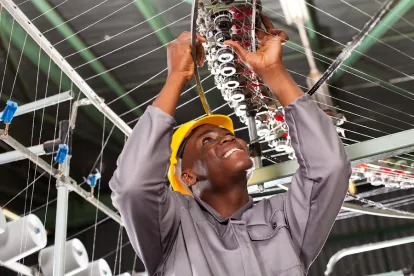Economists and industry leaders have identified a continuing shortage of skilled labor in all areas in manufacturing for decades, a situation made worse by the aging and retirement of skilled workers of the Baby Boomer generation. The COVID-19 pandemic adds to the loss of manufacturing jobs and lower levels of workforce participation by workers in all age groups, which has contributed further to the “skills gap” in the industry.
What are the trends in labor participation rates in manufacturing and measures by the Biden administration designed to bolster the workforce?
The labor force participation rate is a measure of the working-age population at least 16 of age who are active in the workforce. To be considered within the labor force, workers must be working or actively seeking work, meaning, the sum of those working and those who are unemployed but seeking work. That measure of workforce commitment peaked at 67.1% in February 2000, after having risen steadily the previous three decades. Since 2000, the overall labor force participation rate has declined steadily, to just 62.9% in 2018.
The downward movement in participation rates in that period can be attributed to two trends. First, the increased level of participation by women bolstered overall workforce growth in the last half of the 20th century, but that growth trend ended with the 20th century. Second, as Baby Boomers grew to constitute a greater percentage of the population, participation rates continued to decline, because Boomers (especially those over 65) are less likely to continue working. In January 2021, the overall workforce participation rate fell to just 61.2%.
During the same period, manufacturing output rose 5%, but became more capital-intensive than labor-intensive. This resulted in a “skills mismatch” — a gap between the skills workers have to offer and those manufacturers need. This skills differential contributed to a decline in levels of manufacturing employment (see, “The Transformation of Manufacturing and the Decline of U.S. Employment,” National Bureau of Economic Research, Working Paper 24468, March 2018).
A total of 7.5 million manufacturing jobs were lost between 1980 and 2017, and men and women aged 21 to 55 with less than a high school degree suffered the greatest impact from lower levels of manufacturing employment. Those losses also likely contributed to the further decline in labor force participation rates, because participation rates are generally lower for older workers.
The COVID-19 pandemic has further contributed to a decline in overall employment and participation rates in the manufacturing sector. Significantly, 582,000 manufacturing jobs were lost between April 2020 and February 2021. Although the overall participation rate was 63.4% at the beginning of the pandemic in February 2020, that number fell to 60.2% by April — below 61% for the first time since 1973.
By November 2020, the participation rate recovered to 61.5%, but, in that month alone, almost 4 million workers reported not seeking work because of the pandemic. In January 2021, the participation rate dipped to 61.2%, although the Bureau of Labor Statistics had projected the participation rate would not fall to 61% until 2026.
While the manufacturing sector largely avoided the disastrous impact of COVID-19 that the service sector experienced, it is being affected by a long-term decline in employment levels of older, skilled workers and an unexpected dip in labor force participation in all age groups coincident with the pandemic.
The Biden administration has announced programs to increase the availability of skilled workers. On February 17, 2021, President Joe Biden issued an Executive Order, pursuant to which the Department of Labor announced actions aimed at accelerating expansion of apprenticeship programs and the “relaunching” of the federal Advisory Committee on Apprenticeship. The administration also has expressed support for the National Apprenticeship Act of 2021, passed by the House of Representatives on February 5, 2021. The bill provides statutory authority for the registered apprenticeship program within the Department of Labor and provides related grant programs, among other provisions.





 />i
/>i

